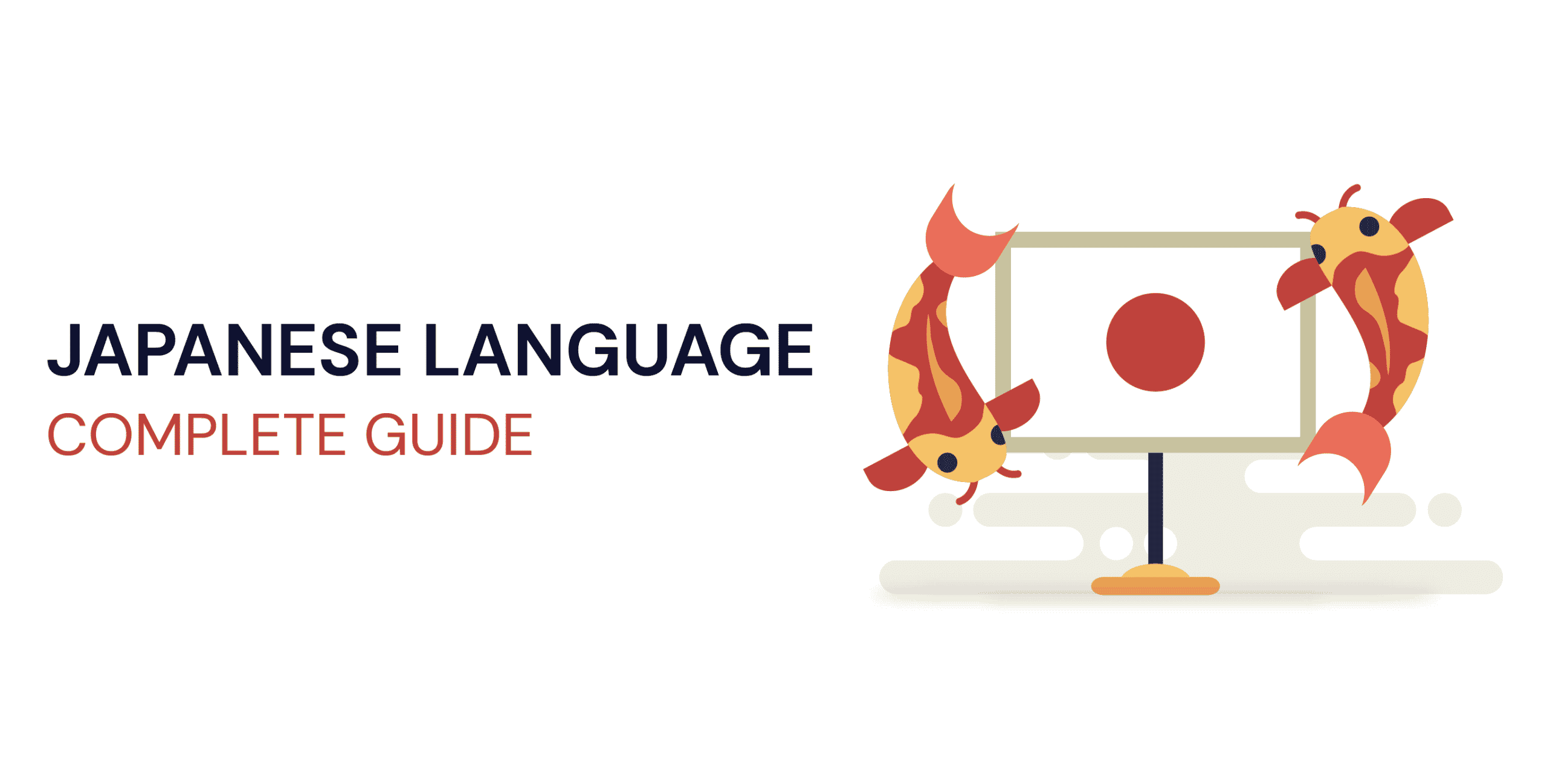Japanese Language: Complete Guide
Updated: 14. Feb, 2023
One of the most popular languages to study in the West is Japanese. The Japanese language and culture intrigues many people so much that they want to learn how to speak it.
At first, learning Japanese may seem difficult. Reading an alphabet you have never heard of might seem like an impossibly difficult challenge. Irrespective of how learning Japanese is, being fluent in it can be really rewarding.
In this post, we will go through a study approach for learning Japanese for beginners that are both effective and easy to understand.
Overview of Japanese
Japanese is a member of the Japonic language family. The Japonic language family is distinct from the rest of the Indo-European family. There are a variety of dialects of Japanese spoken across Japan under this family. The changes in syntax and verb conjugation among these dialects are usually minor.
The origins of the ‘Japanese’ language are obscured by the passage of time and geography. After the Chinese language was brought to Japan in the 5th century AD, historians started piecing together the history of the current Japanese language.
Educated Japanese people picked up the Chinese language and script, which they used to express their own language in writing form for the first time. Japanese as we know it now has its roots in this region.
Japanese is sometimes referred to as an “isolated” language since it has so little in common with other languages. Despite the fact that Japanese has few direct linguistic ties, it has been impacted by other languages for hundreds of years and has taken numerous loanwords from them.
Dialects
Dialect diversity is common in Japan. Japan having many dialects is not a surprise to historians. The island has long been populated. Additionally, it is located in an area that is naturally isolated. It is home to several shogunates that were isolated from exterior events until the late 19th century.
There are 47 prefectures in Japan, and as in other nations, each prefecture has its own dialect. Pitch accents, inflections, lexicon, and particle use are the most common variances among these dialects. In certain cases, they employ vowels and consonants differently. Depending on the dialect, you may even discover that the difference between formal and casual Japanese might sound rather different.

Standard Japanese (Eastern Japanese and Tokyo-type Japanese)
This dialect is mostly spoken in Hokkaido, Tohoku, Kanto region, and Chubu region. Within a decade after Japan opened its borders in 1853, the Meiji Restoration brought the country together as a significant global force.
Besides being taught in classrooms, it is used for broadcast on television and utilized in formal contexts. It is also possible to split Japanese into two categories: kogo (‘oral language’) and bungo (‘literary language.’) In terms of syntax and vocabulary, the two versions diverge. Even after World War II, Bungo remained an essential literary and historical tool for the Japanese people. Today, the term “Kogo” is most often used.
Western Japanese (Kansai-ben)
This dialect is spoken in the Kansai, Chugoku, Shikoku, and a part of the Chubu region. This is analogous to how cultural and linguistic differences split the North and South of the United States. Kyoto, the former capital, and the surrounding territories evolved a distinctive dialect through time due to the distance between the two cities. Like southern American English, Western Japanese has a reputation for shortening its vocabulary.
Writing Systems
The alphabet is the first hurdle that all Japanese students must overcome while beginning their language studies. Hiragana, Katakana, and Kanji are the three distinct writing systems used in Japanese. All of these are crucial for Japanese learners to know.
Hiragana
Hiragana is one of the first things you must learn when studying Japanese. As a component of the Japanese writing system, learning Hiragana is critical.
It is one of the three Japanese writing systems you must master to read. To use most basic Japanese textbooks and materials, you will need to know how to read Hiragana. You learn it right away in a regular school setting.
Even though Hiragana alone will not teach you everything, it is the most important tool for learning how and why Japanese words sound the way they do. In addition, you’ll lay the groundwork for a natural-sounding accent as a result of this experience.
There are 46 characters in the Japanese writing system known as Hiragana. Each character has its own unique sound, yet there is no underlying meaning to be found within them. The Hiragana character must be mixed with other Hiragana characters to convey a meaning. It is used for terms that originate from Japan.
Katakana
Katakana contains 46 characters as well. Characters written in Katakana have the same sounds as those written in Hiragana.
Words borrowed from other languages are often written in Katakana. Since Kanji is difficult to read, many Japanese people choose to write their names in Katakana.
It is also customary for the surname of a Japanese lady who marries a foreigner to be written in Katakana. Katakana is sometimes used to write nicknames.
Kanji
Characters in the Japanese language known as Kanji are Chinese characters exclusively used in written form. Mixing two or more Kanji characters to generate new meaning for each character is possible.
Many Kanji characters may also be spoken in different ways. Even though over 47 000 Kanji characters exist, less than 2,000 are utilized daily in Japan.
Kanji plays an important role in the language’s written communication. The pronunciations of several Japanese words are quite similar, making it difficult to distinguish between them. Once you see the Kanji used to write the term, you’ll understand its precise meaning.
Sentence Structure and Syntax
The structure of Japanese sentences differs from that of English.
The grammatical structure in English is as follows
“Subject + Verb + Object.”

It’s “Subject + Object + Verb” in Japanese. This implies the verb is always at the end of the phrase, necessitating a conceptual adjustment in how you create sentences. Furthermore, when describing nouns, Japanese words are placed in the opposite position as English terms. You should insert a noun that you wish to explain at the end.
Grammar in Japanese
When learning Japanese, knowing the proper grammar to use is key. The following are things to take note of:
1. Verbs
Japanese verbs have only two main tenses. They are the present and the past. Present-tense verbs can also indicate what will happen in the future.
Another important aspect of Japanese grammar is verb conjugation. In Japanese, you must add “-ed” to the end of a verb to indicate past tense, just as you would in English.
In Japanese, there are several verb conjugations. Each conjugation of a verb has its own set of rules. Understanding and remembering how to employ all of the verb conjugations is critical. It’s an important aspect of learning Japanese.
Additionally, Japanese has very few irregular verbs. When compared to English, Japanese has a small number of irregular verbs and a relatively regular verb conjugation system.
In general use, there are fewer than ten irregular verbs. This is a significant difference compared to the hundreds of irregular verbs often used in English. Only two or three of the ten irregular verbs are used regularly.
This implies that conjugating Japanese verbs is very easy once you grasp their rationale. You won’t have to memorize a lot of irregular verb forms since most verbs are conjugated in the same manner.
2. Pronouns
In contrast to Indo-European languages, Japanese does not have any real pronouns. Instead, a subset of nouns is known as daimeishi. Daimeshi accepts modifiers and is not a closed class. Names or titles are often employed in Japanese phrases in place of pronouns, making personal daimeishi less common than in Indo-European languages like English.
Vocabulary
Borrowings from other languages abound in Japanese vocabulary lists. Japanese has a core vocabulary made up of native Japanese terms and those acquired from Chinese and other languages.
When the Japanese adopted Chinese spelling, they drew much from it. Linguists have compared the influence of Chinese writing on Japanese to the Norman conquest’s impact on the English language. Synonyms for Japanese terms are often found, one from Chinese and the other from Japanese. The term kanga refers to words of Chinese origin (Sino-Japanese). To Japanese speakers, they often look more official. Also, there are claims that Sino-Japanese terms make up to 60% of the Japanese lexicon.
Different Ways to Learn Japanese Fast
If you want to hasten your learning pace, then you should do the following:

1. Enroll in Language Schools
If you have the financial means and the desire to learn Japanese, enrolling in a Japanese language school in Japan is one of the most efficient methods. They provide a solid basis for learning Japanese, and you may utilize them to hone your abilities.
When it comes to learning Japanese, it’s a good idea to take a Japanese language course to learn how to properly speak and write Japanese characters.
In addition, you’ll learn a lot of useful terms that you’ll use on a regular basis. This approach allows many individuals to become proficient in Japanese in a year or two. When you study Japanese in a language school in Japan, you will spend 4 hours per day, or 20 hours per week on average, learning the language.
2. Watch Subtitled Movies
Many individuals learn English through watching films and television shows. You’d finally figure out how words went together and form sentences if you had subtitles.
Depending on how much you already know, you’ll constantly think about various ways the subtitles’ words go together while you study this manner.
Most of the time, you’ll have some thoughts that turn out to be incorrect, but that’s okay. It will stay with you when you eventually come up with the proper concept. Furthermore, you will have discovered some of how the language does not always function as expected. Above all, it is a fun method to pick up some Japanese.
3. Manga
Manga (comics) are popular in Japan. There are hundreds of publications available in a variety of genres. The benefit of learning Japanese via comics is that you may use the furigana, or little Hiragana, to assist you with reading Kanji.
Furigana, the little Hiragana or Katakana characters next to each Kanji character, are common in Japanese children’s books and manga. Furigana stories can aid in the acquisition of basic Kanji.
4. Join a Community
When learning, it is possible to get frustrated. When this happens, don’t let yourself become discouraged. Every Japanese student has been there. That’s why it’s essential to join a learning community that will help you progress.
A supportive learning environment, whether in person or online, will provide students with linguistic resources, empathetic ears, and practical assistance to help them succeed. Also, communities are terrific avenues to practice Japanese and meet others who speak the language.
5. Podcasts
Learning Japanese using podcasts is a great method to do so. They’re free, and you can listen to them while doing anything else that doesn’t require a lot of concentration, such as walking, commuting, or cleaning.
The more you listen, the more you’ll be able to comprehend and communicate in Japanese. There are a lot of Japanese podcasts accessible to listen to on the internet. They vary in difficulty from novice to expert. You should make podcasts a part of your daily routine for the greatest effects.
6. Write Kanji Regularly
Learning Kanji is easier when you write it down. Writing and pronouncing the words teach you how they look. As you learn Kanji, the sound and idea will gradually become a part of you. Lastly, write more complete sentences rather than simply individual letters.
7. Study Grammar
Studying grammar, particularly verb conjugations and particles, is critical to learning Japanese. Even if you comprehend every word in a Japanese statement, you may still be unable to grasp the deeper meaning. If you’re looking for a term in a dictionary, you may not be able to locate it. To understand why this happens, you need to know how to conjugate a verb.
8. Listen More
You must listen to Japanese daily to become proficient in the language. It’s simple, but it’s also really effective. Listening to a lot of Japanese can help you learn the language’s grammar naturally. A lot of the time, reading it out of a textbook doesn’t help you grasp it.
In addition to this, if you listen and hear the same language you’ve just studied, you’ll have a better understanding of how Japanese people use it.
As with grammar, so too with vocabulary. Flashcards or textbooks alone aren’t adequate for most students. Within a few days, you’ll have forgotten about it. Listening to a word or phrase again and over will help you remember it since your brain will recognize it as valuable information.
9. Use It
It’s not enough to just study Japanese. It’s important to utilize your language in order to improve your fluency.
Those who study Japanese in a Japanese language school in Japan rapidly become proficient because of this.
They have the opportunity to put it to good use since they call Japan home. Since they want to live and work here, they must be able to communicate in the language of Japan.
Conclusion
Now, you know vital things to learn if you want to learn Japanese. Above all, when learning, consistency is key. You will not be able to grasp the language in a few months. It’ll take a long time.
There is no need to be a genius in order to learn Japanese; all you need is to keep practicing the key concepts like grammar, pronunciation, etc. Above all, stay determined and practice every day.
Table of contents
Read more
Lingopie Review: A Complete Guide (for 2023)
Lingopie is similar to Netflix; the only difference is that you learn a new language while watching TV. The...
READ ARTICLE
Duolingo Review: A Complete Guide (for 2023)
Are you interested in learning a new language in a fun and low-pressure manner? Are you confused about whic...
READ ARTICLE
Rosetta Stone Review: A Complete Guide (for 2023)
When learning a new language, you want to be able to do so as fast as possible. You want to immerse yoursel...
READ ARTICLE



